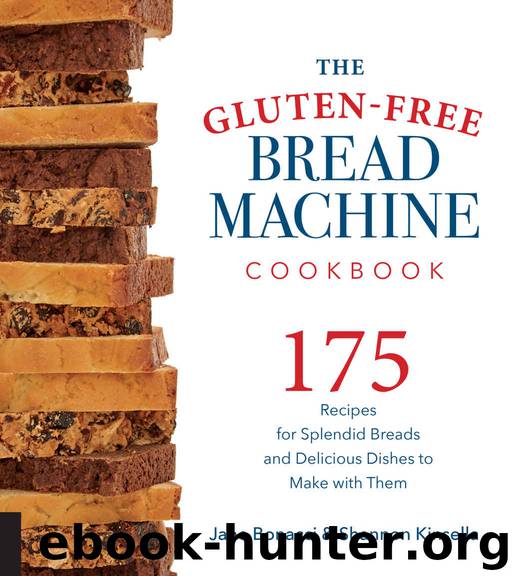The Gluten-Free Bread Machine Cookbook: 175 Recipes for Splendid Breads and Delicious Dishes to Make with Them by Bonacci Jane & Kinsella Shannon

Author:Bonacci, Jane & Kinsella, Shannon [Bonacci, Jane]
Language: eng
Format: epub
Publisher: Harvard Common Press
Published: 2016-12-14T16:00:00+00:00
SOURDOUGH CIABATTA
MAKES 1 (2-POUND/910 G) LOAF
Ciabatta is a wonderful Italian bread traditionally shaped in a long oval that resembles a slipper. When you use a sourdough starter to make it, you add another dimension, depth, and richness to the flavor. This is a wonderful way to use the starter that you remove before feeding. There is no reason to throw it down the drain when you can be enjoying breads like this! Because this gluten-free dough is so soft, you will get the best results if you use a slender baking pan with sides. This contains the dough, and the sides support it as it rises. We found one called a “biscotti pan” (12 × 5 1 /2 × 2 inches/30 × 14 × 5 cm) from USA Pan that works like a champ (see Resources ). This pan is extremely efficient at heat distribution, so keep an eye on the bread; if it is baking and browning too quickly, turn down the oven temperature by 25 degrees.
DRY INGREDIENTS
4 teaspoons active dry yeast
360 g (12.7 oz or 3 cups) Light Flour Blend or Whole-Grain Flour Blend
44 g (1.6 oz or 1 /2 cup) milk powder
39 g (1.4 oz or 3 tablespoons) granulated cane sugar
2 teaspoons psyllium husk flakes or powder
2 teaspoons kosher or fine sea salt
WET INGREDIENTS
240 ml (1 cup) sourdough starter, at room temperature
3 large eggs, at room temperature (see here ), beaten
90 ml (1 /4 cup plus 2 tablespoons) water, warmed to about 80°F (27°C)
45 ml (3 tablespoons) vegetable or olive oil
TOPPING
Vegetable oil
Coarse sea salt, optional
Sourdough starter must be at room temperature before using. If your starter has been refrigerated, pull out 1 cup (240 ml) and set it on the counter for about 2 hours to warm up to room temperature. You do not have to have recently fed the starter, but if you are taking out a cup, it’s always a good idea to go ahead and feed the remaining starter (see directions ).
1. Brush a long slender baking pan (see headnote) generously with vegetable oil. For extra insurance you can line the pan with parchment, leaving it extended over two sides to create “handles” that makes it very easy to remove the bread from the pan. Lightly oil the parchment.
2. Set the bread pan on the counter and insert the beater paddle(s). Unless otherwise directed by your machine’s manufacturer, add the liquids first, then the dry ingredients, and finally the yeast.
3. Measure the yeast into a small bowl and set aside. In a large mixing bowl, whisk the remaining dry ingredients together.
4. In a 4-cup (1-liter) glass measuring cup, whisk the wet ingredients together and pour into the bread pan. Use a spatula to spread the dry ingredients over the wet ingredients, covering completely. Make a shallow well in the center and pour in the yeast.
5. Place the bread pan in the machine, settle it in the center, and lock it in place. Close the lid and select:
Dough cycle
Loaf size: 1 1 /2 pounds/750 g
Start
6.
Download
This site does not store any files on its server. We only index and link to content provided by other sites. Please contact the content providers to delete copyright contents if any and email us, we'll remove relevant links or contents immediately.
The Bone Broth Miracle: How an Ancient Remedy Can Improve Health, Fight Aging, and Boost Beauty by Ariane Resnick(16552)
How to Be a Bawse: A Guide to Conquering Life by Lilly Singh(7389)
The Fat Loss Plan by Joe Wicks(4846)
The Ultimate Bodybuilding Cookbook by Kendall Lou Schmidt(3884)
The French Women Don't Get Fat Cookbook by Mireille Guiliano(3604)
A Jewish Baker's Pastry Secrets: Recipes from a New York Baking Legend for Strudel, Stollen, Danishes, Puff Pastry, and More by George Greenstein(3544)
Better Homes and Gardens New Cookbook by Better Homes & Gardens(3524)
Super Food Family Classics by Jamie Oliver(3366)
Dinner in an Instant by Melissa Clark(3110)
Bread Revolution by Peter Reinhart(3082)
Tom Kerridge's Dopamine Diet: My low-carb, stay-happy way to lose weight by Kerridge Tom(3063)
Body Love by Kelly LeVeque(3012)
Ottolenghi - The Cookbook by Yotam Ottolenghi(2869)
Flavor Flours by Alice Medrich(2813)
The Fat Chance Cookbook by Robert H. Lustig(2791)
Tone Your Tummy Type by Denise Austin(2785)
Oh She Glows Every Day by Angela Liddon(2727)
LL Cool J's Platinum 360 Diet and Lifestyle by LL Cool J(2685)
The Kitchen Counter Cooking School by Kathleen Flinn(2484)
